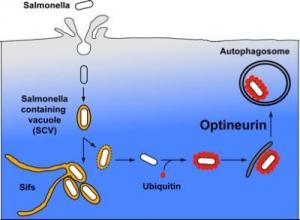摘要:在动物王国里,沙门氏菌是广泛流行的。我们之所以不会遭受严重的肠道感染,往往是因为我们身体的防御系统——它能够消化入侵的细菌。一般来说,这也是为什么一个健康的人如果食用一些有污染的食品来源比如说鸡蛋、肉类,消化了超过100万个沙门细菌便会生病的原因。

Scheme of Salmonella infection and clearance via autophagy pathway.
The reason we do not suffer from severe intestinal infections very often is due to our body's defence system, which manages to digest invading bacteria.An international team of researchers, led by Prof. Ivan Dikic from the Goethe University in Frankfurt has now found out how body cells recognise salmonella and render it harmless. Understanding this process at a molecular level is crucial in identifying new targets for treatment. Tropical and sub-tropical countries in particular, where various sub-species of salmonella are common, are experiencing a rapid increase in resistance to antibiotics, with children at greatest risk.
Salmonella infection begins with bacteria entering the epithelial cells of the intestinal mucosa. To prevent them multiplying there, special cell organelles, called autophagosomes are activated. These encircle the invaders and then become absorbed in other organelles -- lysosomes -- that contain certain special digestive enzymes, which break down the bacteria into their constituent parts. But how exactly do the autophagosomes recognise salmonella? Prof. Ivan Dikic and his research group at the Biochemistry Institute II have now shed light on this mechanism.
As reported in a current article in the journal Science, the salmonella are marked as 'waste material' by the molecule ubiquitin. In order for the autophagosomes to become active, the marked bacteria have to bind to another molecule -- LC3 -- on the autophagosomal membrane. Here, the protein optineurin plays a key role, linking the marked Salmonella to the autophagosmal LC3, thereby setting off a process of selective autophagy. But optineurin becomes active as a link only after being chemically modified by an enzyme, (in this case it is phosphorylated by the protein kinase TBK1). "We suspect that phosphorylation acts as a regulated switch to trigger selective autophagy of bacteria but might also prove significant in other cargoes like protein aggregates or damaged mitochondria" explains Prof. Ivan Dikic, underlining the importance of these findings. It is thought that impaired autophagy processes may be implicated in, among other things, the development of cancer as well as neurodegenerative diseases.
In the area of infectious diseases, these findings are particularly relevant in view of the fact that gastrointestinal disease caused by Salmonella enterica has rapidly increased since the mid-1980s. In Germany, approx. 30,000 cases were reported to the health authorities in 1985, but by 2005 the figure has risen to 52,000. Worldwide, 94 million people fall ill each year with acute gastroenteritis, and 155,000 of these die. Typhoid, a disease also caused by Salmonella, affects 16 million people annually and mortality rates reach 200,000, with children in particular falling victim to the disease. Bacteria are becoming increasingly resistant to antibiotics so that the potential for treating disease is limited. Chloramphenicol, a formerly popular broad-spectrum antibiotic, is now ineffective, and even Fluoroquinolones, currently a commonly prescribed antibiotic, is proving inadequate in fighting bacteria. As co-author Prof. Dirk Bumann from the Biozentrum at Basel University puts it: "There is a pressing need to find new forms of treatment for infectious diseases. A better understanding of how the body's own defence mechanism makes use of autophagy will certainly help."







